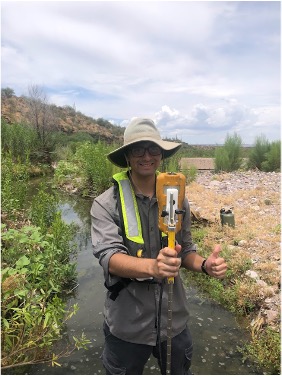— Samuel Booker
It was an honor and my pleasure to be awarded the Leonard Halpenny Intern Scholarship, which seeks to provide undergraduate students with an opportunity to gain invaluable practical experience working in hydrology and water resources.
The companies that hosted me last summer and fall were Clear Creek Associates (CCA), Tucson Water, the USGS Arizona Water Science Center, and Montgomery & Associates (M&A). Overall, I am beyond grateful for this experience, as I got to network with many professionals and gained valuable insight into what many potential career paths could look like.
My first host company was CCA, a consulting firm that provides services and solutions to groundwater problems for a variety of different clients. I had no idea what a consulting career would look like before my time spent with CCA, so I was quite excited to learn everything I could. One thing I learned was how important collaboration was. I got the chance to visit a drill site near Randolph Park golf course and realized the amount of planning that went into undertaking a project like this. From correspondence to the drilling company, mapping out the utility lines, or even clearing the project site of trees and other obstructions, communication is paramount. I also got to learn about ADWR’s well policies and regulations. Lastly, I got to visit the Santa Cruz River Heritage Project with Jamie Kennealy, where she gave me a rundown of CCA’s contribution to this project.
Next I got to work with Tucson Water, which prides itself on the management of water resources for the city of Tucson and its residents. I got to tag along with Hector Zamora, who works in Tucson Water’s recharge unit, on a trip to CAVSARP and SAVSARP. These basins take in CAP water, infiltrating it back into the regional aquifer. He gave me an overview of the process and the development history of the site. An added bonus to the visit was all of the wildlife we got to see, such as coyotes, various waterfowl and even a pair of crested caracara. I also got to visit the same drilling site I visited with CCA, this time with Scott Gallo, a hydrologist at Tucson Water, this time from the perspective of Tucson Water’s role in the project. My time with Tucson Water was personally rewarding being a lifelong Tucson resident, as I got some insight into how Tucson Water stewards over Tucson’s water supply, ensuring its residents have access to water, which is especially important in a desert community where water is becoming an increasingly scarce resource.
After that I got to work with the USGS, where I spent the majority of my time out on the field with the hydro tech team. I had previously attended a field trip with the USGS as part of one of my courses at the UA so I was very excited. I was able to get hands-on experience with stream gaging and learned how to use an acoustic doppler velocimeter to do so. The USGS is the standard when it comes to data collection, and I could see why. I saw the amount of care each of the hydro techs took and the measures taken to ensure the data was up to standard. Not only that but I got to enjoy the outdoors while doing so. One of my favorite sites I got to visit was a stream near Aravaipa Creek. Something I considered when choosing to study hydrology was the opportunity to work outside in nature and I feel like my time with the USGS certainly scratched that itch.
The last company I worked with was M&A, another consulting firm based in Tucson. I took a day trip to Phoenix to take a look at more well sites as well as to get an overview of drilling procedures by Andrew Feltman. For the rest of my time spent at M&A, I got to work with past Halpenny recipient Marla Odom on issues of PFAS (per and polyfluoroalkyl substances). PFAS, also known as forever chemicals, and their existence in water supplies have become quite a relevant issue lately. I gained experience in data analysis, got to do a geospatial survey of PFAS concentrations and profiles based on well data, and was encouraged to think critically about the situation.
I think a takeaway I have from the experience was the importance of critical decision making skills. Problems in the real world aren’t as controlled as a homework problem and oftentimes can be solved in many different ways. I got firsthand experience in seeing how these professionals take on those problems, and how their perspectives and other factors weighed into those decisions. I also think I learned a lot about work that goes beyond technical skill, such as work-life balance and interpersonal relationships. Overall, I think this experience has made me better equipped to pursue a career in hydrology and water resources. I am excited for what the future holds!

